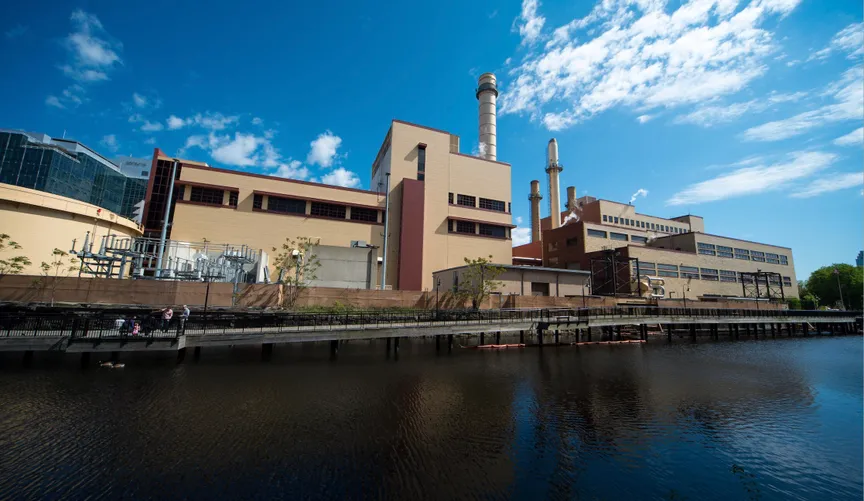
In the depths of the 75-year-old Kendall Cogeneration Station along the Charles River in Cambridge, Massachusetts, a clean-heating transformation is underway.
For years, the facility has burned natural gas to produce steam for Boston and Cambridge’s century-old underground heating system. Now, it’s aiming to become a clean “district energy” system, capable of delivering warmth during bitter New England winters without baking the planet — a first for a citywide network in America.
Last year, Vicinity Energy, the owner and operator of the steam heating network, finished installing a 42-megawatt electric-powered boiler at the Kendall facility. Earlier this year, the company confirmed plans for its next step: installing a 35-megawatt industrial heat pump from Everllence, a German energy systems manufacturer formerly known as MAN Energy Solutions.
“That project was greenlit this summertime,” Vicinity Energy CEO Kevin Hagerty told Canary Media, and demolition to make way for the new heat pump has already begun.
“We’re anticipating that being completed midway through 2028. We’ll turn the heat pump on and turn the Charles River into a renewable energy resource,” Hagerty said.
The industrial heat pump will draw from the river water’s latent thermal energy to create boiling-point temperatures within the Kendall facility’s steam-generation complex. The technology will function even in the winter because the low-temperature refrigerant it uses is far colder than even the icy-cold Charles, creating a temperature differential that the heat pump can harness to produce steam.
All that steam flows through about 25 miles of piping to heat roughly 70 million square feet of buildings in Boston and Cambridge, including college campuses and biotech facilities. Vicinity has secured commitments to use the lower-carbon steam from its electric-powered heating systems from area customers such as Emerson College and life sciences real estate company IQHQ.
Hagerty said other “very large offtakers are underwriting this,” although he declined to name them. “The pump is not fully subscribed yet, but it’s getting there.”
The system will be among the biggest in the United States, which has roughly 900 district energy systems ranging from those in airports and on college campuses to the citywide steam network in Manhattan, the country’s oldest. District heating is also popular in European cities, where comparatively high fossil-gas prices are driving a more urgent embrace of large-scale clean-heating systems.
For customers in Cambridge and Boston, Vicinity’s “eSteam” plan makes sense for reasons of political economy, Hagerty said. Massachusetts has set mandates to expand its supply of carbon-free electricity and to reduce its use of fossil fuels in buildings. A preexisting, centralized system like the Kendall facility’s can convert to electric heat pumps and boilers far more cost-effectively than individual buildings could on their own, he said.
“It’s about one-half to one-fifth the cost for buildings to use our eSteam and electrify through the district energy system than it is for them to locally electrify and decarbonize,” Hagerty said.
Most of those savings come from the fact that the Kendall facility’s electric grid substation and steam pipe network are already built, he said. That obviates the need to retrofit individual buildings with electric heating — or for utilities to make distribution grid upgrades to accommodate a heat pump at every building.
District energy systems like Vicinity’s also benefit from economies of scale, Hagerty said. Large, centralized networks can mix and match mutually reinforcing technologies like electric boilers and heat pumps. They can recapture waste heat from other parts of the system and use it to make more steam, as is being done with the Kendall facility’s gas-fired electricity-generation turbine, which provides peak power and “black start” services for the local grid.
District energy systems can also store and shift energy, as Vicinity plans to do with the thermal energy storage that makes up the next stage of its eSteam conversion plan. It’s looking at systems that can convert electricity into heat storage, which would “allow us to relieve the stress on the electric grid and be a lot more flexible,” he said.
If anything, the Boston-Cambridge system is only starting to utilize the cost-effective decarbonization strategies that district energy systems enable, Hagerty said. Europe is leading the way on that front, with showcase projects such as the 70-megawatt industrial heat pumps now using the chilly water of the Baltic Sea as a thermal exchange to heat water to keep buildings warm in the city of Esbjerg, Denmark.
“They currently have the largest industrial-scale heat pump for district energy in the world,” said Alejandro Gorosito, U.S. national sales manager for Everllence, which provided the heat pump for the Danish city. It won’t hold that distinction for long, he said — Everllence is building a 150-megawatt heat pump for a similar project in Cologne, Germany.
In Europe, adoption of industrial heat pumps is helped along by the fact that fossil fuels tend to be more expensive than electricity. Because heat pumps are far more efficient than fossil-fueled options, they can be the most cost-effective choice when electricity is cheaper, Gorosito said — a fact that can push companies without climate goals to pursue the clean-heat technology.
In much of the United States, where fossil fuels are abundant and power prices are rising fast, the math doesn’t favor heat pumps, Hagerty conceded. But for Boston and other cities that require building owners to reduce their carbon emissions, and for states like Massachusetts that aim to decarbonize their economies, district energy systems can serve as a “regulatory hedge for our customers,” he said.
“They need to make decisions as to whether or not they’re going to heat their building with natural gas, because we’ve got regulations in place that are going to start enacting fines … Do they want to take the risk of spending millions of dollars on something that they may not be able to use in five to 10 years?”